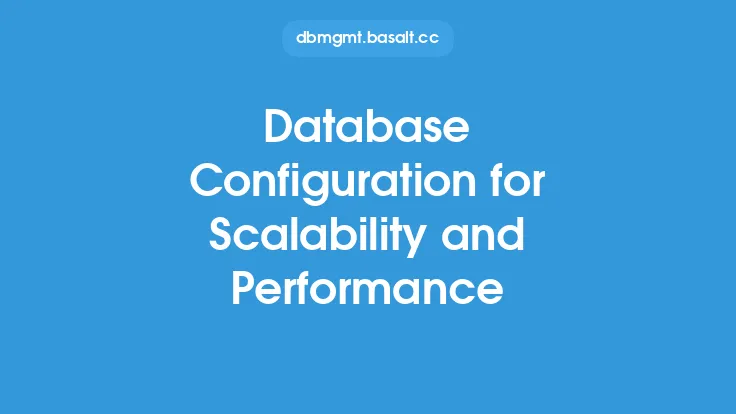To ensure high availability and fault tolerance in databases, configuration tuning plays a crucial role. High availability refers to the ability of a database to remain accessible and functional at all times, while fault tolerance refers to the ability of a database to continue operating even in the event of hardware or software failures. Achieving these goals requires careful planning, configuration, and tuning of database parameters.
Introduction to High Availability and Fault Tolerance
High availability and fault tolerance are critical aspects of database configuration, as they directly impact the reliability and uptime of the database. A highly available database is one that can handle failures and recover quickly, minimizing downtime and data loss. Fault tolerance, on the other hand, refers to the ability of a database to continue operating even when one or more components fail. To achieve high availability and fault tolerance, database administrators must carefully configure and tune database parameters, such as replication, clustering, and backup and recovery settings.
Database Replication for High Availability
Database replication is a technique used to maintain multiple copies of a database, ensuring that data is available even in the event of a failure. There are several types of replication, including master-slave, master-master, and multi-master replication. Master-slave replication involves designating one database as the primary database (master) and replicating its data to one or more secondary databases (slaves). Master-master replication involves designating multiple databases as primary databases, allowing data to be written to any of the databases. Multi-master replication involves designating multiple databases as primary databases, allowing data to be written to any of the databases, and using conflict resolution techniques to resolve any inconsistencies. Database replication can be configured to occur in real-time, ensuring that data is always up-to-date and available.
Database Clustering for Fault Tolerance
Database clustering involves grouping multiple databases together to form a single, logical database. Clustering provides fault tolerance by allowing the database to continue operating even if one or more nodes fail. There are several types of clustering, including shared-disk clustering, shared-nothing clustering, and distributed clustering. Shared-disk clustering involves multiple nodes sharing a common disk storage system, allowing any node to access the data. Shared-nothing clustering involves each node having its own disk storage system, and data is replicated across nodes. Distributed clustering involves multiple nodes, each with its own disk storage system, and data is distributed across nodes. Database clustering can be configured to provide automatic failover, ensuring that the database remains available even in the event of a node failure.
Backup and Recovery Configuration
Backup and recovery configuration is critical to ensuring high availability and fault tolerance. Database backups can be configured to occur at regular intervals, ensuring that data is always available in the event of a failure. There are several types of backups, including full backups, incremental backups, and differential backups. Full backups involve backing up the entire database, while incremental backups involve backing up only the data that has changed since the last backup. Differential backups involve backing up all the data that has changed since the last full backup. Database recovery can be configured to occur automatically, ensuring that the database is restored to a consistent state in the event of a failure.
Configuration Tuning for High Availability and Fault Tolerance
To achieve high availability and fault tolerance, database administrators must carefully tune database configuration parameters. This includes configuring replication, clustering, and backup and recovery settings, as well as tuning database parameters such as buffer pool size, log file size, and lock timeout. Buffer pool size determines the amount of memory allocated to the database buffer pool, which can impact performance. Log file size determines the amount of disk space allocated to the database log files, which can impact recovery time. Lock timeout determines the amount of time a transaction can hold a lock on a resource, which can impact concurrency. By carefully tuning these parameters, database administrators can ensure that the database is optimized for high availability and fault tolerance.
Monitoring and Maintenance for High Availability and Fault Tolerance
Monitoring and maintenance are critical to ensuring high availability and fault tolerance. Database administrators must monitor the database for signs of trouble, such as errors, warnings, and performance degradation. This can be done using database monitoring tools, such as SQL Server Management Studio or Oracle Enterprise Manager. Regular maintenance tasks, such as backups, indexing, and statistics gathering, must also be performed to ensure that the database remains healthy and optimized. By monitoring and maintaining the database, database administrators can identify and resolve issues before they impact availability and fault tolerance.
Best Practices for High Availability and Fault Tolerance
To achieve high availability and fault tolerance, database administrators should follow best practices, such as configuring replication and clustering, tuning database parameters, and monitoring and maintaining the database. Additionally, database administrators should ensure that the database is properly sized and configured for the workload, and that adequate resources, such as CPU, memory, and disk space, are available. Database administrators should also ensure that the database is properly secured, with adequate access controls and encryption, to prevent unauthorized access and data breaches. By following these best practices, database administrators can ensure that the database is optimized for high availability and fault tolerance.
Conclusion
In conclusion, database configuration tuning plays a critical role in achieving high availability and fault tolerance. By carefully configuring and tuning database parameters, such as replication, clustering, and backup and recovery settings, database administrators can ensure that the database remains available and functional at all times. Additionally, by monitoring and maintaining the database, and following best practices, database administrators can ensure that the database is optimized for high availability and fault tolerance. By prioritizing high availability and fault tolerance, organizations can ensure that their databases are always available and functional, minimizing downtime and data loss, and maximizing productivity and efficiency.





